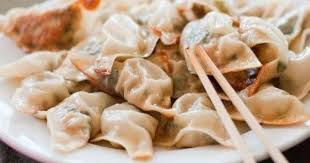
Dumplings are made by stuffing fillings into thinly rolled wrappers created through kneading dough and sealing the edges. This dish has different types depending on the ingredients used, which reflect not only a particular place's distinct characteristics but also an individual's tastes. Considering that mandu contains ground meat and various greens, it shows the unique feature of Korean food that emphasizes on meats and vegetables.
The term "mandu" is cognate with the names of the same types of meat-filled wraps along the Silk Road in Central Asia, where mandu is believed to have come from. Such wraps are the Uyghur manta, Kazakh mänti, Turkish and Uzbek mantis, and American mant'i. Chinese mantou is also regarded a cognate, which formerly means meat-stuffed dumplings, but is now called "steamed buns," which don't have any filling.
Mandu, which contains minced vegetables, ground meat, and other stuffing, can be fried, steamed, or boiled. If the dumplings are grilled or fried, it is called gunmandu, if heated, jjinmandu, and if boiled, mulmandu. It is a seasonal dish, which means the ingredients used depends on its availability. Most of the time, mandu is stuffed with ground meat, tofu, ginger, green onions, and garlic.
This dish was served originally only at winter festivities and in the royal court. It has been part of Korean royal court cuisine during the Joseon Dynasty, which lasted from 1392 to 1910. But mandu has become an essential part of daily Korean cuisine over time. It is now available in supermarkets, restaurants, and even in snack places all over Korea, and is served not just in wintertime but also in ancestral rites and other special celebrations.
Moreover, this Korean-style dumpling is a usual dish made and eaten by the whole family together at the start of the Lunar New Year for the excellent health and well-being of the members. Mandu is considered a representation of good luck for the forthcoming year.
One type of mandu is the somandu, which is only filled with vegetables. It was initially consumed at Buddhist temples but has become part of the vegetarian community. Mandu is commonly served with the famous kimchi and an accompanying dip, which is a mixture of soy sauce and vinegar with chili.
Don't miss the chance to taste this nutrient-rich wraps when you visit Korea!









